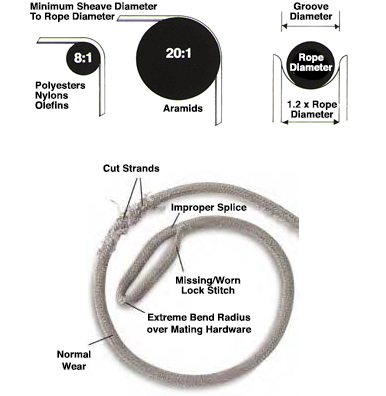Usage, Storage and Care
Storage and care
All rope should be stored clean, dry, out of direct sunlight and away from extreme heat. Some synthetic rope may be severely weakened by prolongued exposure to ultraviolet (UV) rays, unless specifically stabilized and/or pigmented to increase its UV resistance. UV degradation is indicated by discoloration and the presence of splinters and slivers on the surface of the rope. To properly unreel rope, a shaft should be inserted through the center of the reel, and the rope should be pulled off the top while the reel is free to rotate. Reverse rope ends regularly to promote even wear and assure a longer life. Apply a steady, even pull to achieve full strength from rope or synthetic cable. Formulas to determine reel and storage capacities (use inch reel dimentions):
| Rope length (feet) |
= | (traverse width) (flange diameter2 – barrel diameter2) |
| (16) (rope diameter2) |
Formulas to determine bin capacity: V=(C)2 x (L) x (R)
V = volume in cubic inches
C = rope circumference in inches
L = length of rope in feet
R = 1.58 for carefully stores rope or 2.0 for random packing
CAUTIONS
Overloading and Use of Working Loads
Because of the wide range of rope use, exposure to the several factors affecting rope behavior and the degree of risk to life and property involved, it is impossible to make blanket recommendations as to working loads. However, to provide guidelines, working loads are tabulated for rope in good condition with appropriate splices, in noncritical applications and under normal service conditions.
A higher working load may be selected only with expert knowledge of conditions and professional estimate of risk, and if the rope has not been subject to dynamic loading or other excessive use; if the rope has been inspected and found to be in good condition, and is to be used in the recommended manner: and if the applications do not involve elevated temperatures, extended periods under load or obvious dynamic loading, such as sudden drops, snubs or pickups. For all such applications, consult Yale.
Many uses of rope involve serious risk of injury to personnel or damage to valuable property. This danger is often obvious, as when a heavy load is supported above one or more workers. An equally dangerous situation occurs is personnel are in line with a rope under tension. Should the rope fail, it may recoil with lethal force. Persons should be warned against the serious danger of standing in line with any rope under tension.
In all cases where such risks are present, or there is any question about the loads involved or the conditions of use, the working load should be substantially reduced. Minimum breaking strength is based on test data of new, unused rope and is a value not greater than two standard deviations below the mean.
Dynamic loading voids normal working load
Normal working loads are not applicable when rope is subject to significant dynamic loading. Instantaneous changes in load constitute hazardous shock load and would void the normal working loads.
Whenever a load is picked up, stopped or swung, there is an increased force due to such dramatic loading. The more rapidly actions occur, the greater the increase will be. In extreme cases, the force put on the rope may be two, three, or even more times the normal load involved and may result in the rope parting. Examples could be picking up a tow on a slack line or using a rope to stop a falling object. Therefore, in all dynamic applications, working loads as given do not apply.
Users should be aware that dynamic effects are greater on a low-elongation, high-modulus rope such as Aramid and lesser on a higher-elongation, nylon-based product. Dynamic effects are greater on a shorter rope than on a longer one. The working load ratios listed contain provision for very modest dynamic loads. This means, however, that when the working load has been used to select a rope, the load must
be handled slowly and smoothly to minimize effect and avoid exceeding provision for it.
Example:
A load of 3,500 lbs is being lowered using 5/8” diameter Double Esterlon, which has a maximum recommended working load of 3,400 lbs. With 15 feet of line in tension, the line accidentally slips, dropping the load 1 foot before arresting the fall.
Question:
How much energy did the rope have to absorb, and has the rope been overloaded or damaged?
Work done (ft lbs): (weight)(length of fall) = 3,500 ft lbs
Rated maximum working energy absorption
Capacity = (weight of the rope in use)(working energy absorption capacity rating for the rope used)
From the data page, Double Esterlon has a working energy absorption capacity of 291 ft lbs per pound of rope and a weight of 13.7 lbs per 100 ft of 0.137 lbs/ft.
Rated maximum working energy-absorption capacity of 16 feet of 5/8” Double Esterlon = (16 ft)(0.137 lbs/ft)(291 ft lbs/ lb) = 638 ft lbs.
In this example, 2.19 lbs of rope (16ft x 0.137 lbs/ft) in use must absorb 3,500 ft lbs : or 3,500 ÅÄ 2.19 lbs equals 1,596 ft lbs/lb of rope.
In this example, the maximum working energy-absorption capacity has been exceeded by nearly six (6) times. The effect is to drive the max. load the rope encounters until it arrests the load or breaks.
Rated ultimate energy absorption of 16 feet of 5/8” Double Esterlon = (16 ft)(0.137 lbs/ft) (7,711 ft/lbs/lb) = 16,902 ft lbs, and any dynamic load exceeding this total would break the line. Note that there is a linear relationship between the weight of the rope in tension versus its energy-absorption capability. In the above example, some degree of the rope’s integrity has been compromised, and the prudent safety practice would call for downgrading or discarding the line.
Abrasion: Avoid all abrasive situations. Rope can be severly damaged if subjected to rough surfaces or sharp edges. Chocks, bits, winches, drums and other surfaces must be kept in good condition and free of burrs and rust. Sheaves must be free to rotate and should be of proper size to avoid excessive wear. Clamps and similar devices will damage and weaken the rope and should be used with the extreme caution. Do not drag rope over rough ground. Dirt and grit picked up by rope can work into strands, cutting the inside fibers and reducing the rope’s strength.
Chemicals: Avoid chemical exposure, as rope is apt to be damaged. Consult Yale for recommendations when a rope will be used where chemical exposure can occur.
Temperature: The tensile strength charts apply to ropes tested at normal room temperature (70oF). Ropes have lower tensile strengths at higher temperatures. Continued exposure at elevated temperatures can melt and part synthetic ropes or cause permanent damage.
Dielectric Strength, as shown in the catalog, is offered as a guideline to help you compare various fibers and constructions. We recommend that you consider all ropes, regardless of their initial new rated dielectric strength, as conductive in service.
Splicing: Join rope by splicing. Use Yale’s recommended splices for maximum efficiency. The strengths shown in this catalog are for spliced lengths. Other terminations can be used, but their strength loss with a particular type of rope and construction should be determined and not assumed.
Knots and abrupt bends significantly reduce the strength of all ropes and lower the maximum working load.
|
Avoid using rope that shows signs of aging and wear. If there is any question, destroy the used rope. No type of visual inspection can be guaranteed to accurately and precisely determine actual residual strength. When the fibers show wear in any given area, the rope should be respliced, eliminating the damaged area; downgraded; or replaced. Check the line regularly for frayed strands and broken yarn. Pulled strands should be rethreaded into the rope if possible. A pulled strand can snag during a rope operation. Both the outer and inner rope fibers contribute to the strength of rope. When either is worn, or the rope is compacted or hard, this indicates reduced strength. The dielectric strength of rope in this condition is also reduced. |
 |



